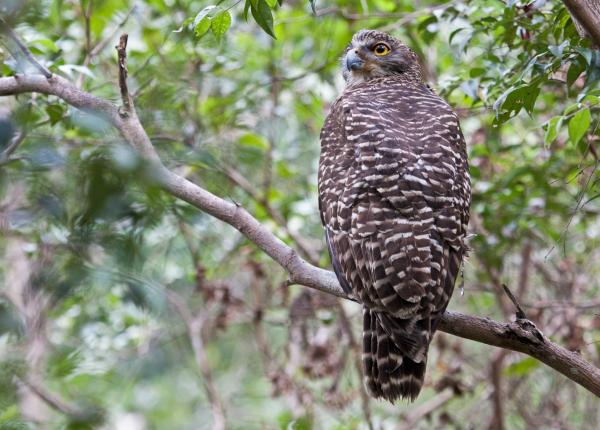Did You Know?
- The Powerful Owl is one of the largest owls in Australia
- It is sometimes called the Powerful Boobook
How The Peregrine Fund is Helping
Though The Peregrine Fund doesn't work directly with the Powerful Owl, our efforts in scientific research, habitat conservation, education, and community development help conserve raptors on a global scale. We also supply literature to researchers from our avian research library, which helps scientists around the world gather and share important information on raptor conservation. Additionally, our support of the Global Raptor Information Network gives raptor researchers tools to more efficiently conduct their own studies while contributing to a global program. It also provides citizen scientists a way to participate in raptor science and conservation.
Where They Live
Powerful Owls are native to Australia. They are found in the eastern and southeastern part of this island nation from sea level to around 1,500 meters above sea level. They occupy a plethora of different habitats including dry forest, woodland, pine tree plantations, botanical gardens, landscaped parks, mangroves, eucalyptus groves, and some coastal areas.
What They Do
Like most owl species, the Powerful Owl is nocturnal, or active at night. Like many bird species, the Powerful Owl enjoys a good bath from time to time. It has been observed bathing in pools and streams, mostly right before dawn and just after dusk.
Why They Need Our Help
Even though the Powerful Owl is categorized as a species of Least Concern, it still faces some threats throughout its range. Perhaps one of the greatest threats is loss of old-growth forest, which also affects prey availability and nesting sites.
What They Eat
As you can imagine, this large and powerful owl is an adept hunter, able to catch a number of different prey of many different sizes. It specializes in capturing medium-sized arboreal mammals including gliders and possums. It will also feed on bats, rodents, rabbits, wallabies, and even young koalas! But its long list of prey animals doesn't stop there. It also feeds on birds including herons, frogmouths, magpies, and choughs. It is also known to hunt other raptors, and has been documented preying upon Gray Goshawk! It will also feed on much smaller prey items such as crayfish, crickets, and beetles. It is also known to scavenge on carrion from time to time.
Nests, Eggs, and Young
Like most owl species, the Powerful Owl does not build a stick nest. Rather, it lays its eggs in holes or cavities in live or dead trees, tree stumps and trunks. The male is responsible for getting the nest hole ready for the female. When the time is right, the female will lay one to two eggs, which she will be in charge of incubating. Over the following 35-40 days she will spend long hours sitting on her eggs making sure they are kept safe and at just the right temperature for the developing embryos to survive. During this time, the male is busy catching enough food to feed himself and the female. After the young hatch, they are covered in thin white down. Over the next few weeks they will continue to get bigger and their flight feathers will slowly grow in. Nearly two months after hatching, the owls will be ready to fly for the first time.
But flying is just one of the skills a young owl has to learn. It also needs to become skilled at hunting and avoiding dangers. The young owls will spend the following six or seven months after they fledge with their parents learning how to survive on their own.
Powerful Owl and the World Center for Birds of Prey
Though far from Powerful Owl territory, the World Center for Birds of Prey offers fun ways to learn about birds of prey. Interactive activities, tours, interesting videos and a children's room with activities from coloring sheets to quizzes to costumes await you. At our visitor center, you can see live owls up close, including an Eastern and Western Screech-Owls, a Verreaux's Eagle-Owl, and an Eurasian Eagle-Owl. Come learn about the wonderful and interesting adaptations they have in order to survive in their respective habitats. There is also a touch table with owl feathers and other natural objects available for exploration.
References:
Olsen, P.D., J. S. Marks, and G. M. Kirwan (2020). Powerful Owl (Ninox strenua), version 1.0. In Birds of the World (S. M. Billerman, B. K. Keeney, P. G. Rodewald, and T. S. Schulenberg, Editors). Cornell Lab of Ornithology, Ithaca, NY, USA. https://doi.org/10.2173/bow.powowl1.01
https://www.owlpages.com/owls/species.php?s=3080










